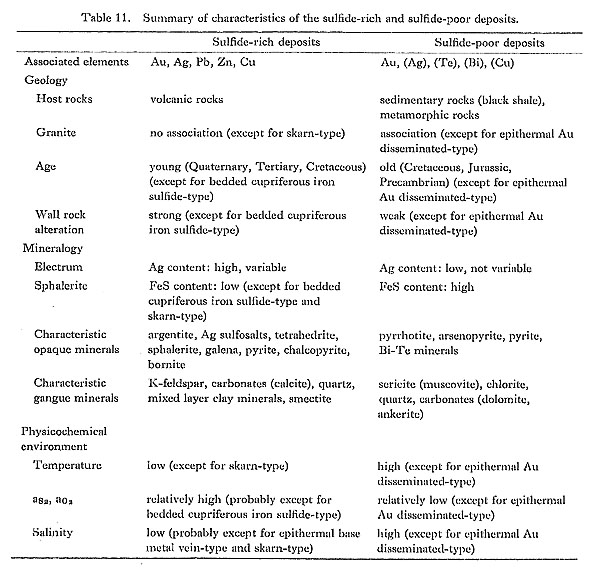CHAPTER VII
Summary and Conclusions
|
Electrum from different types of Au-Ag deposits in Japan, the Korean Peninsula, and Taiwan was studied. They include vein-type (epithermal, hypo/mesothermal), epithermal Au disseminated-type, stratabound massive sulfide-type (Kuroko-type, bedded cupriferous iron sulnde-type), skarn-type, and alaskitc-type deposits. They were divided into two types: sulfide-rich and sulfide-poor. These two types of deposits occur in different geologic environments. The sulfide-rich deposits occur mainly in young (chiefly Tertiary and Cretaceous) volcanic rocks (andesitic and rhyolitic). The sulfide-poor deposits occur in sedimentary rocks (mainly black shale), gneiss, and regionally metamorphosed rocks, which are usually old, ranging from Precambrian to Cretaceous. Usually, the ages of host rocks for the sulfide-poor deposits are older than those for the sulfide-rich deposits. The characteristic features of the sulfide-rich and sulfide-poor deposits which have distinctly different mineralogical, geochemical, and geological features are summarized in Table 11.
Chemical compositions and mode of occurrence of electrum from these various types of deposits have been studied. These mineralogical studies of electrum revealed the followings. (1) As a whole, the Ag content of electrum varies widely, ranging from almost pure Au to pure Ag. (2) The Ag content of electrum is different in different types of deposits. For instance, Ag-rich electrum occurs in the sulfide-rich deposits (epithermal vein-type, hypo/mesothermal vein-type, Kuroko-type and skarn-type deposits). The range of variation in the Ag content of electrum from these types of deposits is wide. Au-rich electrum occurs in the sulfide-poor deposits (hypo/mesothermal vein-type, alaskite-type and disseminated-type). The Ag content of electrum in these deposits does not vary widely. (3) Compositional zoning is frequently observed in a grain of electrum from the sulfide-rich deposits. Usually, the Ag content increases from the core to rim of a grain. The variation range of the Ag content in a grain from the sulfide-poor deposits is not wide. (4) The Ag content of electrum depends on the minerals coexisting with electrum. The Ag content for argentite-, K-feldspar-, and carbonate-rich deposits (sulfide-rich deposits) is high. The Ag content of sericite-rich and K-feldspar-, carbonate-, and argentite-poor deposits (sulfide-poor deposits) is low. Generally, Bi, Te and Cu minerals are associated with Au-rich electrum, whereas Pb, Zn, Ag, Sb, and Se minerals are associated with Ag-rich electrum. Pyrrhotite and arsenopyrite tend to coexist with Au-rich electrum, and pyrite with Ag-rich electrum. (5) FeS content of sphalerite coexisting with electrum from the sulfide-poor deposits is high (usually more than 5 mole %), while it is low (uusally less than 5 mole %). The Ag content of electrum and FeS content of sphalerite correlates inversely. (6) Cu, Sb, and Hg in electrum are rarely detected by the electron microprobe analysis. These specimens occur in the ore deposits which formed under low aS2 condition. (7) The minerals in direct contact with electrum are quartz, clay minerals (sericite, chlorite/smectite, sericite/sniectite), sulfides (argentite, chalcopyrite, galena, pyrite, Ag sulfosalts) in epithermal Au-Ag vein-type deposits, and quartz, organic matter, clay minerals (e.g., chlorite), pyrite, arsenopyrite, and Bi-Te minerals in hypo/mesothermal vein-type deposits. Carbonates and K-feldspar are common in epithermal vein-type deposits, although they are not in direct contact with electrum. The factors controlling the Ag/Au ratio of electrum were theoretically considered. These considerations were compared with the data on natural electrum. These studies suggested the followings. (1) The factors controlling the Ag content of electrum precipitating from ore-forming fluids in which Au thiocomplexes, Au chloride complexes, and Ag chloride complexes predominate are considered to be temperature, aH2S, aS2, aO2, aCl-, pH, and ∑Ag/∑Au. (2) Among the factors mentioned above, the correlations of Ag content with temperature, salinity, and pH were shown. The Ag content correlates inversely with temperature, pH, and salinity. (3) The Ag content of electrum varies in accordance with coexisting minerals (argentite, hessite, naumannite, aguilarite, pyrite, arsenopyrite, and pyrrhotite). This suggests that other factors (aO2, aS2, aSe2, aTe2, ∑S, ∑Se, ∑Te, ∑As, ∑Bi) may also affect the Ag content of electrum. (4) Thermochemical calculations suggest that high Hg, Sb, and Cu contents of electrum indicate relatively low aS2 conditions. (5) Physicochemical features of epithermal and hypo/mesothcrmal ore-forming fluids responsible for the Au-Ag mineralization have been estimated They are summarized as follows: (i) ∑Au/∑Ag is 10-1-10-2 for both ore-forming fluids. This range is similar to or slightly higher than the average Au/Ag of crustal rocks. (ii) The temperature, aS2, aO2, and salinity are distinctly different. Temperature of epithermal ore-forming fluids is lower than that of hypo/mesothermal ore-forming fluids. |
